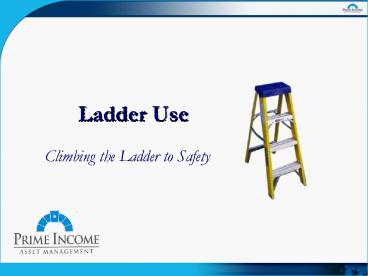Ladder Use PowerPoint PPT Presentation
1 / 18
Title: Ladder Use
1
Ladder Use
- Climbing the Ladder to Safety
2
Ladder Accidents
- Over 25,000 work-related accidents each year
- Many result in severe injuries or death
- Most common injuries include sprains, cuts,
bruises, head injuries, broken bones - Annual cost of compensation and medical treatment
reaches into the millions of dollars - Indirect costs (worker replacement, retraining,
and loss of productivity) can be up to 4 times
as much!
3
3 Main Sources of Ladder Accidents are
- Ladder (equipment) failure
- Unexpected ladder movement
- User loss of footing or balance
4
Reasons for Ladder Failure
- Improper selection use
- Deterioration due to improper care storage
- Exposure to damaging agents
- chemicals
- heat
5
Preventing Ladder Failure
General prevention techniques include
a. Proper Selection
b. Adequate Inspection
c. Appropriate Use
6
Preventing Ladder Failure
Proper Selection
- Read and follow all manufacturer's instructions
- Don't choose a step ladder when an extension
ladder is needed - Dont use a ladder with obvious structural
defects - Use only wooden or fiberglass ladders near
electrical service or power lines - Attach a single point support where both rails
fail to contact (against columns, poles or
corners) - Check ladder capacity
7
Preventing Ladder Failure
Adequate Inspection
- Look for damaged or loose rungs or side rails
- Note any broken or bent hardware
- Check the condition of extension ladder ropes and
pulleys - Ensure that ladder footings are firmly attached
and tread is intact - Tag a defective ladder out of service report
it immediately - If broken, worn, or damaged beyond repair,
destroy the ladder
8
Preventing Ladder Failure
Appropriate Use
- Keep to its intended purpose
- Dont stand on the back cross bracing
- Dont use an extension ladder as a horizontal
platform (scaffold) - Dont allow more than one worker on the ladder at
a time - Dont load the ladder beyond its maximum intended
load - Protect ladder base from traffic if used in
front of a door, make sure door is locked or
guarded
9
Unexpected Ladder Movement
WHY?
When ladders move unexpectedly, it is almost
always because of improper placement either on
inappropriate surfaces or at an improper angle.
10
Preventing Ladder Movement
- Situate ladders only on firm, level ground - not
in mud, in water, or on an incline
- Ensure that the extension ladders base is at a
minimum distance from vertical that is at least
1/4 of the ladders working height - Ensure an extension ladder reaches at least 3
feet above the landing
11
Preventing Ladder Movement
- Ensure that all ladders are equipped with
slip-resistant footings or shoes
- Fully open stepladders and lock the spreader -
all feet should contact a level supporting
structure
- Do not place the round ends of an extension
ladder downward - Do not take apart extension ladders or use single
sections individually
12
Preventing Ladder Movement
Ladders move when they are not properly tied
off.
- When using an extension ladder, always
- Tie it off
- Brace it at the bottom
- Secure extension rope to lower
- section as back-up for lock assembly
13
Loss of Footing or Balance
Ladder accidents can occur when the user loses
footing (slips) or loses balance
- Chief causes include
- Improper ladder preparation
- Wet shoes
- Carrying materials while climbing
- Overreaching while on the ladder
- Inattention to the job
When ladder users ignore proper operating
procedures or simply fail to employ good common
sense, the results can be disastrous!
14
Preventing Loss of Footing/Balance
To reduce your risk of a fall, follow these
guidelines
- Clean any wet or slippery rungs before use
- Wear slip-resistant shoes
- Always face the ladder
- Keep eyes on the ladder and pay attention to hand
and foot placement
15
Preventing Loss of Footing/Balance
To reduce your risk of a fall, follow these
guidelines
- Lift equipment materials with a rope don't
carry in your hand - Carry smaller tools in pouches around the waist
- Always maintain 3 points of contact (2 feet/1
hand, or 2 hands/1 foot)
- Do not overreach. Keep belt buckle positioned
between the side rails
16
Preventing Loss of Footing/Balance
To reduce your risk of a fall, follow these
guidelines
- Never stand on the top two steps of any ladder
- Do not move, shift, or extend the ladder while
standing on it
17
FINALLY, IT IS ABSOLUTELY NECESSARY THAT YOU
AVOID ALL CONTACT WITH POWER LINES!!
- IF YOU MUST PERFORM ELEVATED WORK NEAR ANY
OVERHEAD LINES - USE A NON-CONDUCTIVE LADDER (FIBERGLASS)
- CONTACT YOUR SUPERVISOR
- WALK THROUGH THE PROCEDURE BEFORE STARTING THE JOB
18
Thank you for your cooperation!

